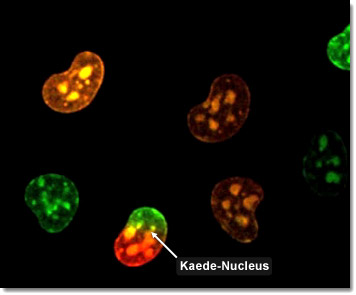The nucleus is a membrane-enclosed organelle found in most eukaryotic cells and houses most of the cell’s genetic material. These components are organized as linear DNA molecules in a complex with a large variety of proteins to form chromosomes. The genes inside these chromosomes are the cell’s nuclear genome. The function of the nucleus is to maintain the integrity of these genes and to control the activities of the cell by regulating gene expression, the process by which inheritable information from a gene--such as its DNA sequence--is made into a functional gene product, such as protein or RNA. In the digital video presented above, normal baby hamster kidney fibroblast cells (BHK line) are expressing a fusion of Kaede fluorescent protein to a nuclear targeting signal peptide.
Video 1 - Run Time: 09 Seconds
Video 2 - Run Time: 03 Seconds
Video 3 - Run Time: 05 Seconds
Video 4 - Run Time: 08 Seconds
Video 5 - Run Time: 04 Seconds
The nucleus is made up of three main sections: the nuclear envelope, the nucleolus, and the chromatin. The nuclear envelope is significant because it allows the nucleus to control the rest of the cell, such as by sending out adenosine triphosphate (ATP). The envelope will let molecules like ATP through but will keep other things in or out, so the nucleus is isolated from the cytoplasm. The nucleolus contains ribosomes, RNA, DNA and has some of the ribosomes that synthesize proteins. The DNA (deoxyribonucleic acid) stores genetic information for a cell). The chromatin contains DNA and proteins formed into packets of code called chromosomes. When the cell divides, the chromosomes fold up on themselves and get wider. In the digital video presented above, normal baby hamster kidney fibroblast cells (BHK line) are expressing a fusion of Kaede fluorescent protein to a nuclear targeting signal peptide.

Not all cells have a nucleus. For purposes of classification, there are eukaryotic cells (those with a defined nucleus) and prokaryotic (those with no defined nucleus). A nucleus isn’t necessary for a cell to possess DNA (deoxyribonucleic acid). In such cases the DNA is usually floating around the cell in a region called the nucleoid. A defined nucleus that holds the genetic code is an advanced feature in a cell. In the digital video presented above, normal baby hamster kidney fibroblast cells (BHK line) are expressing a fusion of Kaede fluorescent protein to a nuclear targeting signal peptide.